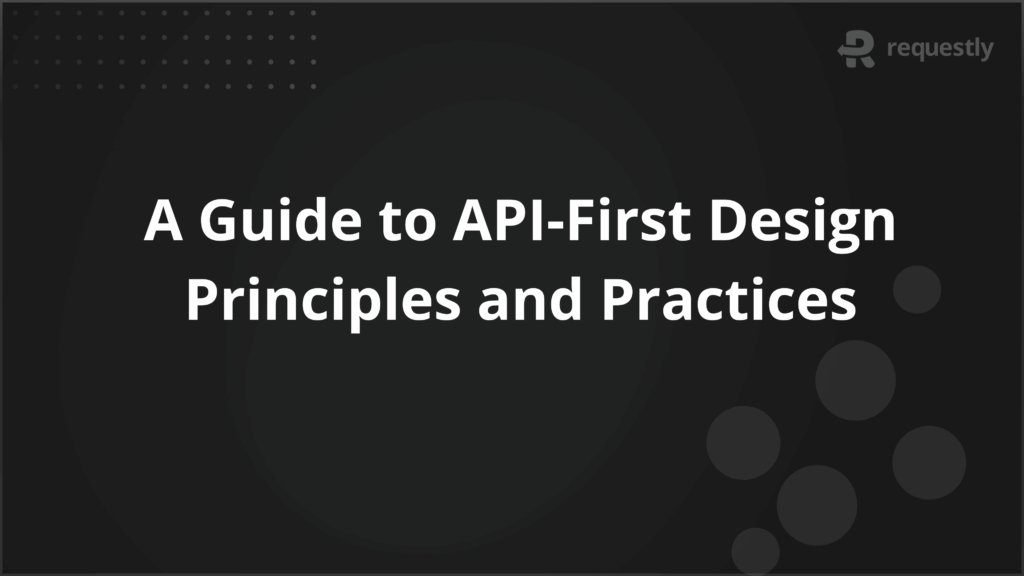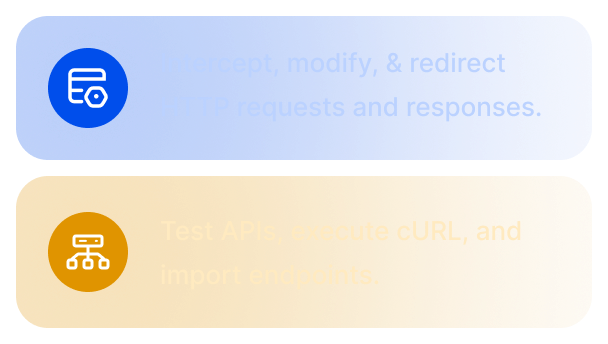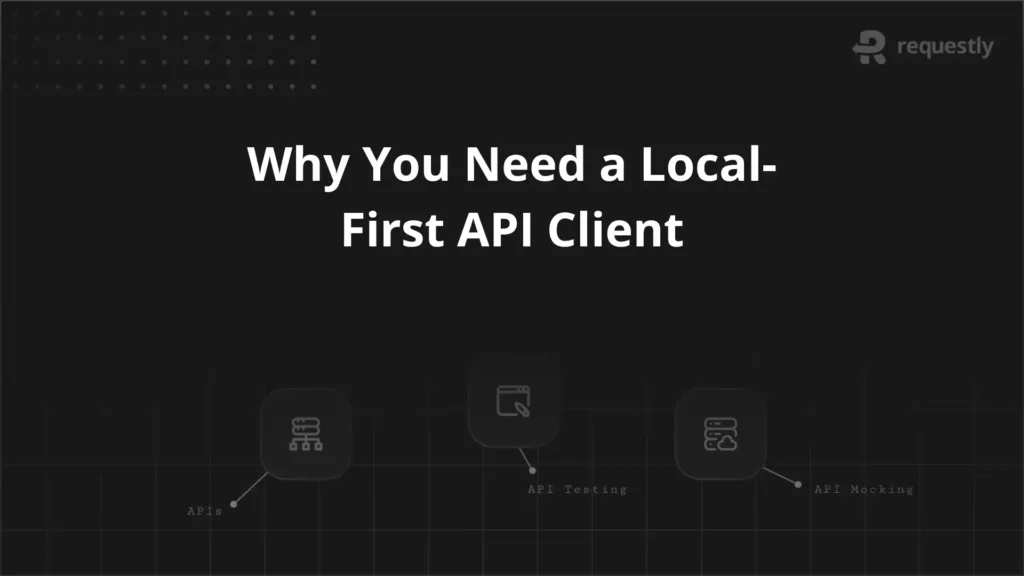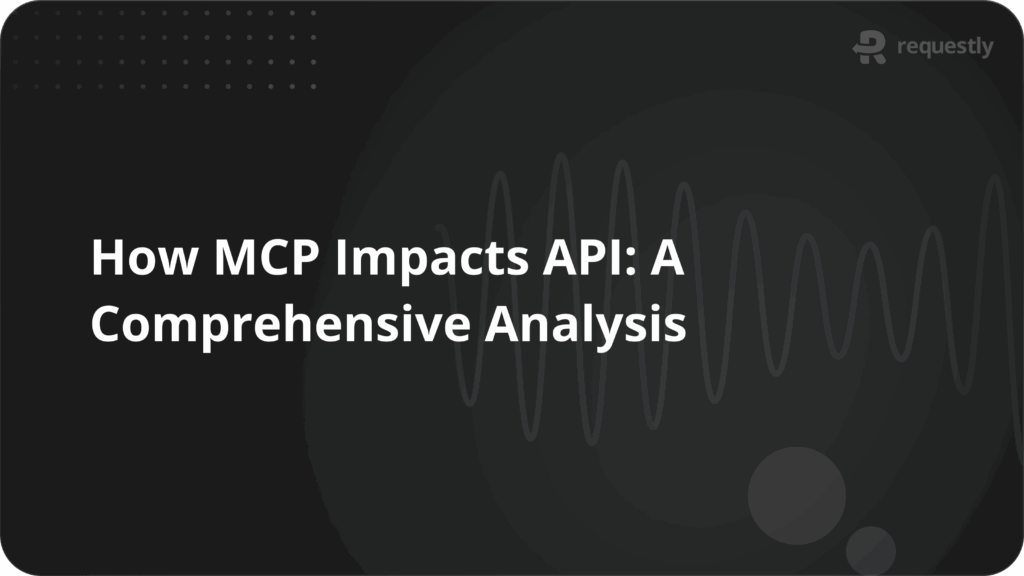A Guide to API-First Design Principles and Practices


APIs have become the backbone of digital products, with more than 90% of developers using them in some form to integrate services, power applications, or enable interoperability.
The API economy is now valued at billions, and enterprises across sectors—from fintech to healthcare—are standardizing their development processes around an API-first approach.
This methodology ensures that APIs are not an afterthought but a core building block of software systems, reducing integration headaches, speeding delivery, and improving product scalability.
Understanding API-First Design
API-first design is a development philosophy where APIs are treated as primary, independent products before any implementation details are coded. Instead of building a backend and exposing APIs afterward, teams begin by defining the API contracts—endpoints, payload structures, response formats, and error handling—using specification formats like OpenAPI or AsyncAPI.
In this approach, the API is not just a technical interface but a product that has its own lifecycle, stakeholders, and quality benchmarks. This enables frontend, backend, and third-party integration teams to work in parallel, all aligning to the same API contract.
Why API-First Matters in Modern Software Development?
Modern applications depend on multiple microservices, external APIs, and distributed teams. Without a consistent, agreed-upon API contract, misalignments quickly escalate into costly delays. API-first design addresses this by:
- Reducing integration issues: Teams build against the same API definition, eliminating mismatched assumptions.
- Accelerating parallel development: Frontend and backend work can happen simultaneously with mock servers and stubs.
- Improving developer experience: Clear, documented APIs reduce onboarding friction for both internal and external developers.
- Supporting scalability: APIs designed upfront can adapt more easily to high traffic, multiple clients, and future product expansions.
Core Principles of API-First Design
API-first design is guided by a set of non-negotiable principles:
- Design before implementation: Define API contracts before writing business logic to avoid rework and inconsistencies.
- Specification-driven development: Use standard formats like OpenAPI to describe endpoints, schemas, authentication, and response codes.
- Consistency across services: Maintain uniform naming conventions, error formats, and authentication mechanisms to improve usability.
- Version control and backward compatibility: Plan for evolutions without breaking existing consumers.
- Developer-first mindset: Treat the API as a product, considering documentation, onboarding, and long-term support.
The API-First Development Lifecycle
The API-first lifecycle follows a structured flow that ensures the API remains consistent, scalable, and maintainable.
- Requirement gathering – Understand the functional and non-functional needs of the application and its consumers.
- API contract definition – Use specification tools to define endpoints, methods, payloads, and expected outputs.
- Mocking and simulation – Create mock servers to validate the design with stakeholders before actual coding begins.
- Implementation – Backend teams code to meet the agreed API specification while frontend teams consume mock endpoints.
- Testing and validation – Conduct unit, integration, contract, and performance tests to ensure adherence to the API spec.
- Deployment and monitoring – Roll out the API to staging or production environments, integrating monitoring for performance and uptime.
- Iteration – Collect feedback and evolve the API while maintaining backward compatibility.
Designing APIs for Consistency and Reusability
APIs that follow consistent patterns are easier to maintain and integrate. To achieve this:
- Follow naming conventions: Use predictable, resource-oriented endpoint names (/users/{id} instead of /getUserDetails).
- Standardize responses: Implement consistent status codes and error message formats across all services.
- Use reusable schemas: Define common request and response schemas for recurring data structures, such as pagination or authentication tokens.
- Leverage hypermedia principles: Provide navigable links in responses to help consumers discover related resources without separate documentation.
Documentation-Driven Development
Documentation is central to the API-first approach. Instead of writing documentation after coding, it is created alongside the API specification.
- Live documentation: Tools like Swagger UI or Redoc auto-generate interactive docs from OpenAPI files, enabling developers to test APIs directly.
- Consumer-focused language: Write docs from the perspective of someone new to the API, not just the team that built it.
- Example payloads: Include realistic request and response examples for all endpoints.
- Change logs: Maintain detailed logs for every update to help users adapt without confusion.
Versioning and Change Management
Inevitably, APIs evolve. Without structured versioning, changes can break client applications.
- Semantic versioning: Adopt the MAJOR.MINOR.PATCH format to indicate the level of change.
- Deprecation policies: Clearly communicate when endpoints will be retired, providing transition guidelines.
- Backward compatibility: Ensure new versions do not disrupt existing client integrations unless absolutely necessary.
- Automated validation: Use contract testing tools to verify that changes don’t introduce breaking differences.
Security and Compliance Considerations
APIs often handle sensitive data, making security non-negotiable.
- Authentication and authorization: Implement OAuth 2.0, JWT, or API key mechanisms based on use case.
- Data encryption: Use TLS for data in transit and encrypt sensitive information at rest.
- Rate limiting and throttling: Prevent abuse by controlling request volumes per client.
- Compliance alignment: For industries like healthcare or finance, ensure APIs meet standards like HIPAA, PCI DSS, or GDPR.
- Input validation: Prevent injection attacks by validating all incoming data against strict schemas.
Creating an API-First Design Workflow
Here are the steps to create an API-First Design Workflow;
- Define Standards and Governance: Establish API style guides, naming conventions, and a chosen specification format (e.g., OpenAPI 3.1). Enforce them with automated linting tools like Spectral.
- Design the API Contract First: Create the API specification before coding, including endpoints, schemas, examples, and security schemes. Store it in version control for collaborative review.
- Generate Mock Servers: Use spec-driven mocking tools (e.g., Prism, Postman Mock Servers) so frontend and backend teams can work in parallel and validate designs early.
- Collaborate and Review: Require stakeholder sign-off on the API contract, run demos against mocks, and log all feedback as tracked issues before implementation.
- Implement from the Contract: Scaffold server stubs and client SDKs from the specification to ensure code and contract remain aligned.
- Test Against the Contract: Run contract, integration, performance, and security tests to verify implementation matches the API specification and meets quality benchmarks.
- Manage Versions and Changes: Apply semantic versioning, maintain backward compatibility where possible, and communicate deprecations with clear migration guides.
- Document Continuously: Generate interactive documentation from the spec and update it alongside API changes, including examples and error references.
- Monitor and Iterate: Track API performance, error rates, and consumer feedback, then evolve the API while preserving stability for existing integrations.
Collaboration Across Teams in an API-First Approach
API-first development thrives on cross-functional collaboration:
- Frontend and backend alignment: Mock APIs allow both sides to work without blocking each other.
- Stakeholder involvement: Business analysts, product managers, and QA teams can review and validate API contracts early.
- Shared repositories: Store API specifications in version-controlled repositories accessible to all teams.
- Feedback loops: Encourage consumer teams to report usability issues and request enhancements.
Testing and Quality Assurance in API-First Development
In an API-first workflow, testing is not an afterthought—it is integral to ensuring that the implemented API matches the agreed-upon contract, performs reliably under various conditions, and meets security and compliance standards.
A structured testing strategy reduces production defects, speeds up debugging, and safeguards the developer experience.
Contract Testing
Contract testing validates that the API implementation conforms exactly to the published specification.
- Schema validation: Ensures request and response bodies follow the defined JSON schema.
- Operation checks: Verifies that endpoints, parameters, and response codes exist and behave as documented.
- Automated enforcement: Run tools like Dredd or Pact in CI to block changes that break the contract.
Integration Testing
Integration testing confirms that the API works correctly within the broader system.
- Cross-service flows: Test multi-step processes (e.g., user signup, email verification, and login).
- Database and third-party dependencies: Verify that backend integrations respond correctly to API calls.
- End-to-end consistency: Ensure API data is displayed and handled correctly by client applications.
Load and Performance Testing
Performance tests measure how the API handles expected and peak traffic loads.
- Baseline metrics: Record p95 latency, throughput, and error rates under normal conditions.
- Stress testing: Identify breaking points by increasing concurrent requests beyond normal usage.
- Scalability checks: Validate horizontal scaling and load balancing strategies.
Security Testing
APIs are frequent targets for attacks, so proactive security checks are critical.
- Authentication and authorization: Confirm that only authorized users can access protected resources.
- Vulnerability scanning: Use DAST tools to detect injection flaws, misconfigurations, and insecure endpoints.
- Rate limiting tests: Simulate abuse scenarios to ensure throttling works as expected.
Regression Testing
Regression tests protect against unintended side effects when changes are introduced.
- Automated suites: Run pre-built API test collections after every change to catch issues early.
- Version-aware testing: Validate both the latest and previous API versions to maintain backward compatibility.
Monitoring in Production
Testing doesn’t stop at deployment—ongoing monitoring ensures continued quality.
- Real-time health checks: Alert teams when API performance drops or error rates spike.
- Consumer usage analytics: Identify underused or problematic endpoints for improvement.
- Synthetic monitoring: Simulate API calls from various regions to detect latency or routing issues.
Requestly for API Testing
Requestly is a versatile tool for debugging, modifying, and testing APIs in real-time. Developers can intercept API requests, modify payloads or headers, and simulate different response scenarios without altering the backend code. Key advantages include:
- Rule-based request manipulation: Redirect or rewrite API endpoints for testing new versions without deployment.
- Latency simulation: Test API behavior under poor network conditions.
- Header injection: Quickly add authentication tokens or custom headers during testing.
- Client-side overrides: Modify frontend API calls to point to staging or mock environments for validation.
Requestly’s API Client is a lightweight yet powerful tool that simplifies API development and debugging. With features like environment variables, pre-request scripts, and real-time collaboration, it’s ideal for quickly testing endpoints, simulating scenarios, and validating API behavior.
Whether working on new features or troubleshooting issues, Requestly’s API Client streamlines the entire API testing process from design to deployment.
Conclusion
API-first design transforms APIs from afterthought integrations into primary, well-structured products. By adhering to clear specifications, fostering cross-team collaboration, enforcing security measures, and using the right tools, organizations can deliver more reliable, scalable, and developer-friendly APIs. In a software ecosystem that depends heavily on integration and interoperability, an API-first strategy is not just a methodology—it’s a competitive advantage.

Contents
- Understanding API-First Design
- Why API-First Matters in Modern Software Development?
- Core Principles of API-First Design
- The API-First Development Lifecycle
- Designing APIs for Consistency and Reusability
- Documentation-Driven Development
- Versioning and Change Management
- Security and Compliance Considerations
- Creating an API-First Design Workflow
- Collaboration Across Teams in an API-First Approach
- Testing and Quality Assurance in API-First Development
- Contract Testing
- Integration Testing
- Load and Performance Testing
- Security Testing
- Regression Testing
- Monitoring in Production
- Requestly for API Testing
- Conclusion
Subscribe for latest updates
Share this article
Related posts






















